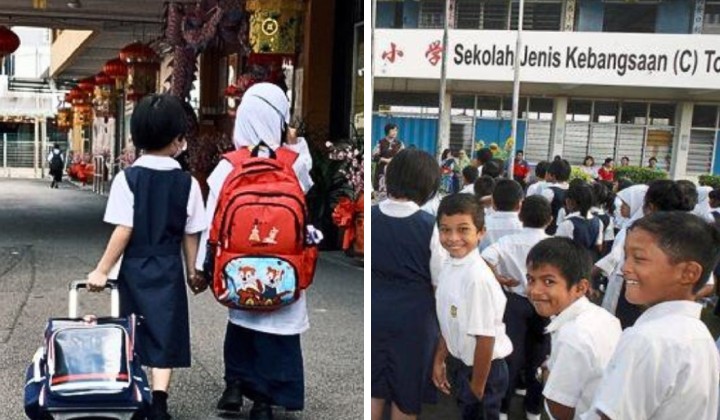The Changing Face Of Malaysian Education: A Chinese School’s Malay Majority
In an unprecedented shift, SJK(C) Chi Sin in Bahau, Negeri Sembilan, has become the first Chinese primary school in Malaysia to have an all-Malay Standard One class.

Subscribe to our FREE Newsletter, or Telegram and WhatsApp channels for the latest stories and updates.
In a surprising turn, SJK(C) Chi Sin, a Chinese primary school in Batu Kikir, Bahau, Negeri Sembilan, has made history by becoming the first school to have an entirely Malay Standard One class.
According to reports in The Vibes, 20 Malay students began their Standard One classes this year, and 62 out of the school’s 66 students are Malays.
This development raises several questions about the state of education in Malaysia and the role of vernacular schools in the country’s multicultural society.
One possible explanation for the increasing number of Malay students in Chinese schools could be the declining Chinese population in Malaysia.
The Chinese population in Malaysia has been decreasing in recent years.
In 2023, the Chinese population was estimated to be 6.4 million, down from 6.5 million in 2022.
For the first time, the Chinese population in Malaysia experienced a negative growth rate in 2023.
This means that the number of Chinese deaths exceeded the number of Chinese births.
Seeking Excellence: The Drive Towards Chinese Schools for Quality Education
At the heart of this movement is the growing inclination of Malay parents towards Chinese schools, driven by a quest for superior educational opportunities for their children.
This shift is not merely a matter of preference but a conscious decision influenced by the esteemed reputation of Chinese schools for academic excellence.
Many parents believe they provide a more rigorous and disciplined learning environment.
Adding to the allure of Chinese schools is the Chinese community’s commitment to education, which is deeply ingrained in its culture.
READ MORE: 65-Year-Old Yong Peng High School Collects RM30mil Donation, A New Record For Chinese School
The Chinese community values self-reliance and communal support instead of relying on government handouts for educational advancement.
There is a strong tradition of generosity within the community, with many willing to donate substantial sums to ensure that future generations receive a quality education.
This perception may lead more Malay parents to send their children to Chinese schools for better educational opportunities.
Lepas tu complain bila org bg sumbangan ke sekolah cina. Sendiri yg susahkan proses. Bagus laa tu. https://t.co/Sf65GuT6HI
— Muhammad Hazeem (@hazz1925) March 21, 2024
Cultural Crossroads: The Debate Over Vernacular Schools in Malaysia’s Melting Pot
The debate over the need for vernacular schools in Malaysia persists for several reasons, despite the apparent fatigue some may feel towards this ongoing discussion.
The Federal Court’s recent ruling reaffirming the constitutionality of vernacular schools underscores their legal standing and the complexity of the debate surrounding their existence and role within Malaysian society.
Certain factions strongly oppose vernacular schools, positing that these institutions foster division rather than unity among Malaysia’s diverse communities.
They argue that such schools, catering primarily to specific ethnic groups, obstruct the path to a cohesive national identity.
This perspective has sparked controversy, particularly as it clashes with the views of the Chinese community, which regards vernacular schools as vital for preserving its cultural heritage and linguistic identity.
The debate takes on an additional layer of complexity as parents who choose Chinese education for their children face criticism from within their community.
The discord doesn’t stop at ideological differences; it extends into everyday aspects of school life, illustrating the depth of the divide.
At the heart of these contentions, the national language often emerges as a central point of dispute.
Critics often scrutinize Chinese schools for even the most minor details, such as the language used on signage, including labels for school toilets.
This fixation on trivial matters perpetuates a cycle of pettiness and vindictiveness, overshadowing more substantive discussions about educational quality and inclusivity.
Ironically, these critics conveniently ignore that parents in national schools are often unwilling to pay for the school’s basic needs, such as essential facilities and educational resources.
Sekolah Jenis Kebangsaan ni parents jenis proactive, parents sendiri sumbangkan duit demi keselesaan anak². Buat charity event. Unlike sekolah kebangsaan mintak RM50 pun bertekak. Or lg teruk gunakan anak² mintak sedekah smua.
— Done (@amirafiq73) March 18, 2024
The Paradox of Praise and Prejudice
Moreover, some critics are called out for their hypocrisy when they express a desire for the facilities and resources of Chinese schools while simultaneously rejecting the vernacular system that underpins these institutions.
Some schools benefit from contributions made by gaming and beer companies, a practice that may not align with the guidelines observed by Muslim communities.
This aspect further complicates the debate, as it introduces religious considerations into discussions about educational funding and the ethical implications of accepting such donations within a multicultural and multi-religious society like Malaysia.
Why Malay wants to ride on minorities effort so much?
— Metaphysics so hard luckily i took engineering (@anakjohortakut) May 21, 2023
Seriously there are lots of HARAM institutions like TOTO and Chinese temples behind SJKC finance.
You guys want to enjoy those facilities and not even bother to mention about them all of a sudden. pic.twitter.com/Df9PdkcQip
Additionally, it’s quite puzzling that some would make it a point to emphasise that Chinese schools exist because of other communities, yet at the same time, are bent on abolishing them.
This contradiction points to a complex interplay of historical gratitude and contemporary political motives, revealing the multifaceted nature of the debate surrounding vernacular education in Malaysia.
SJK(C) Chi Sin’s Blueprint for Malaysia’s Educational Future
SJK(C) Chi Sin has embraced cultural integration despite these tensions, with celebrations like Chinese New Year, Hari Raya, and the mooncake festival jointly celebrated by students and parents.
The school’s headmistress, Won Kew Knew, has also noted that teachers have adopted a special approach to teaching Chinese to Malay students.
The success of SJK(C) Chi Sin in attracting Malay students and fostering cultural integration may offer a model for the future of education in Malaysia.
By embracing diversity and providing high-quality education, schools like SJK(C) Chi Sin can help bridge the divide between ethnic groups and promote a more united and harmonious society.
As Malaysia continues to grapple with the challenges of education in a multicultural society, the example of SJK(C) Chi Sin offers hope for a future in which all students, regardless of their ethnic background, can receive a quality education and learn to appreciate and respect each other’s cultures.
READ MORE: From Bahasa To Bahasa: A Melody Of Unity And Mandarin Mastery
Pelajar Cina memegang tangan dan beriringan dengan pelajar Melayu yang berusia 7 tahun yang sebelumnya menangis.
— CIKY🅰️NIE (@lady_bugg11) March 12, 2024
Pelajar Cina itu datang untuk menenangkannya dan mereka berjalan bersama-sama di Sekolah Yuk Wah di Kajang. Peristiwa ini menunjukkan kesatuan kaum yang indah di… pic.twitter.com/WlyQZfZ2P2
Share your thoughts on TRP’s Facebook, Twitter, and Instagram.





